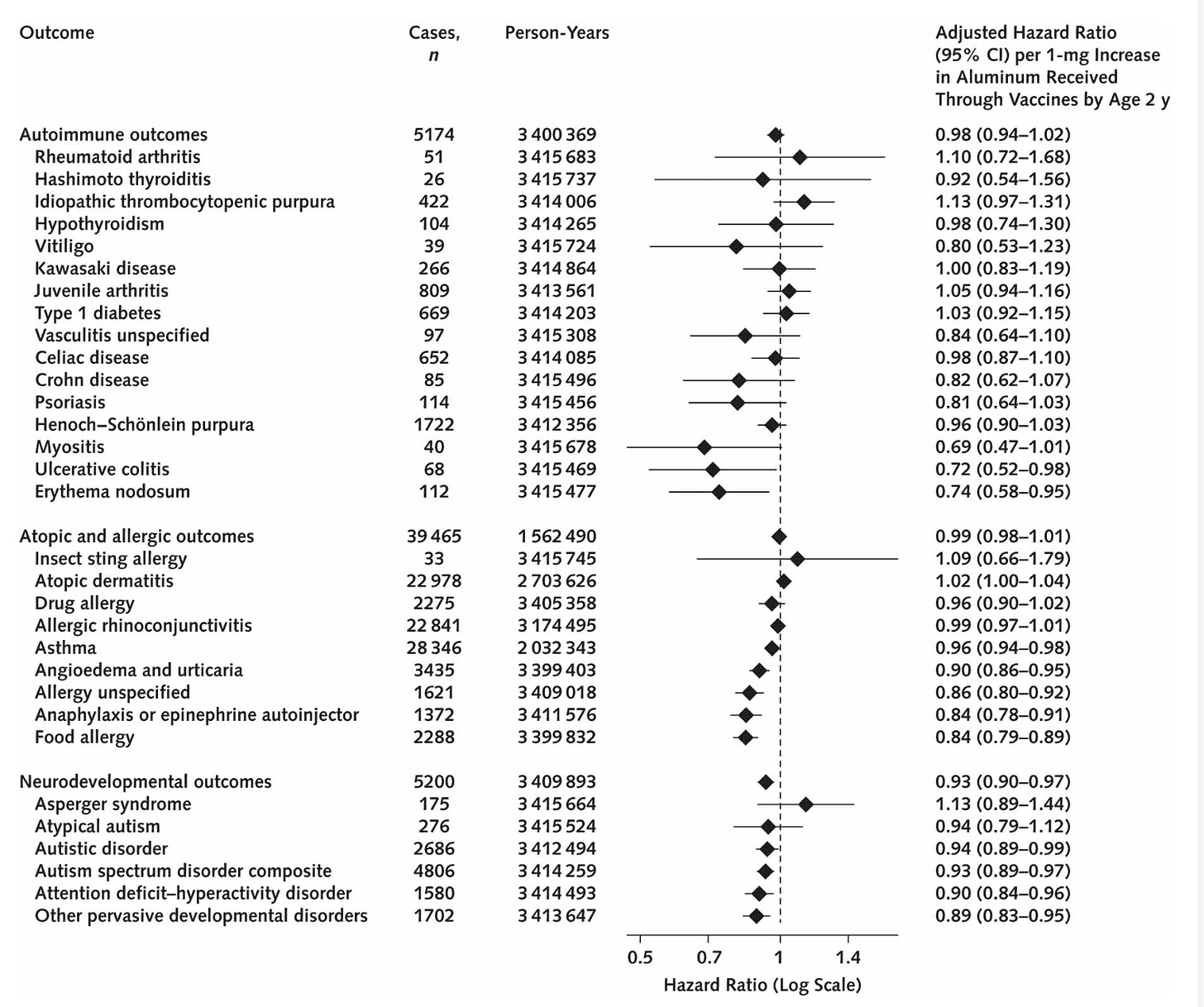The Danish Aluminum-in-Vaccines Study Is Good But Perhaps not Definitive
The Study of the Week addresses the complicated Danish Registry analysis of aluminum in vaccines. I find many lessons of observational analyses
I write today to focus on the methods of observational research—which are complicated. The exposure is aluminum in vaccines; the outcome is childhood illness. There is a lot to think about between these two.
I have visited Denmark and seen first-hand how researchers harness the amazing power of the Danish National Registry. It’s hard for an American to imagine that nearly all of Danish healthcare (baseline characteristics, exposures and outcomes) can exist in one searchable place. US healthcare is infinitely more dispersed.
The Annals of Internal Medicine published a large observational study from Denmark, which looked at aluminum-adsorbed vaccines and chronic diseases in childhood. More than 150 news outlets have covered the results.
The basics of the study is to correlate the exposure (the cumulative dose of aluminum from vaccines) to outcomes (in this case more than 50 different childhood diseases).
Let’s pause a moment to think about the ideal way to answer this question. The only way to really know the answer would be randomization. One group gets aluminum free vaccines and the other gets the standard schedule. You follow for specific outcomes.
But that’s not likely to happen. So the Danish team has to sort out cumulative aluminum doses based on changing Danish vaccine schedules and compounds. Differing years of birth created a natural variation, which then exposed children to different doses of aluminum—in a sort of random way. We call this a quasi-experimental design.
The team then asked how did the differing exposures relate to diagnoses? Of course, since these are not random groups, the authors had to make adjustments based on many variables. Too many to list, in fact.
They then had to decide who to include and who to exclude. The original sample included 1.38 million children. But they excluded children due to emigration, death, congenital conditions, missing co-variates, and those who had the outcome before age 2. They even excluded those children who had too many registered vaccines containing aluminum.
I will come back to the exclusions, but for now, I hope the one word that has popped into your brain is…choices. There are so many darn choices the researchers had to make.
The Results
The main results can be summarized in the headlines of 99% of the news coverage: Danish Study Affirms Safety of Aluminum in Childhood vaccines.
I am not so sure this is correct. Here is my attempt at explaining the results:
The researchers have children who had varying levels of aluminum (hopefully randomly occurring due to natural variation). One group had between 0-1.5 mg, the other had >1.5-3 mg, a third had >3-4.5 mg. They also had a small group (≈ 1-2%) who received no aluminum.
The main analysis was to look at the risk of >50 outcomes (autoimmune outcomes, such as diabetes, allergic disorders, such as asthma, and neurodevelopmental outcomes, such as autism and ADHD) assessed per 1 mg increases in the cumulative exposure during the first two years of life.
The results are shown below
First look at the three main categories (autoimmune 5000+ cases, allergy (39,000+ cases) and neurodevelopmental (5200 cases). None have a positive hazard ratio. Now look under each subheading at specific disorders. Not one had a positive association that was statistically significant.
The authors emphasize that even looking at the upper bound of the hazard ratios, they cannot find a signal of harm from 1 mg increments of aluminum.
They also did numerous sensitivity analyses: looking at exposure at 14 months instead of 2 years; looking at longer duration than 5 years; and looking at different years of birth. The authors write that these uphold the main findings of no safety signal.
The authors conclude:
This nationwide cohort study did not find evidence supporting an increased risk for autoimmune, atopic or allergic, or neurodevelopmental disorders associated with early childhood exposure to aluminum-adsorbed vaccines.
Comments:
What struck me though was the vast number of choices that the authors had to make in analyzing such a large dataset. I take you back to April 2024 when I wrote here on Sensible Medicine about the work of Dr. Dera Zeraatkar at McMaster University.
They published an analysis of studies looking at a much simpler observational question: does red meat consumption associate with survival? They called their work a specification curve analysis, which is a complicated way to say that there were literally a quadrillion different ways to analyze the data. They narrowed it down to…sit down for this…more than 2000 different analyses. Based on analytic choices (covariates, statistical plans etc), the McMaster team showed that some analyses found positive associations with meat and survival, some showed negative associations and most showed null associations. (Brian Nosek’s team has also done similar work on social science questions.)
Zeraatkar and Nosek’s work are exactly what comes to mind when I read the aluminum analysis. It turns out that Robert F Kennedy also wrote about how analytic choices may have led to different results. Sadly he chose a hyperbolic, ugly tone.
Let me show you four key concerns. There are more than four, but these I think are instructive.




